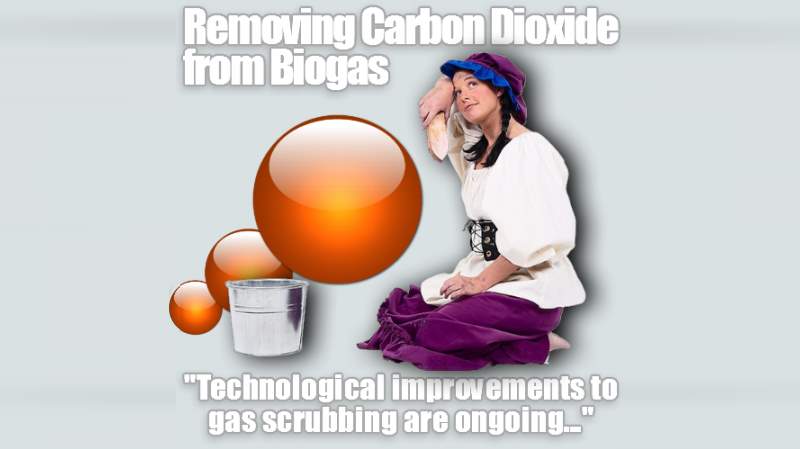
This upgraded gas may also be used for residential heating and as vehicle fuel, so there are many good reasons for removing the CO2. CO2 will always be found in biogas due to the fact that during anaerobic digestion, (i.e. degradation in the absence of oxygen), organic material is decomposed by bacteria forming a mixture of CO2 and CH4 with trace amounts of H2S and water vapour at saturation pressure.
Common methods used to eliminate CO2 from biogas are: - water scrubbing - membrane systems - pressure swing adsorption (PSA) - chemical CO2 absorption - amine gas treatment - CO2 by cooling and recovering dry ice. These systems also generally reduce the H2S and H2O content. Biogas treatment systems, also need to include feed compression on the un-pressurized raw biogas.
Trace components that are often present in biogas are water vapour, hydrogen sulfide, siloxanes, hydrocarbons, ammonia, oxygen, carbon monoxide, and nitrogen. Pressure swing adsorption (PSA) systems, can be thought of as being molecular-sieves for carbon. PSA has been described are the second most commonly used biogas upgrading technology in Europe, after water scrubbing which is most likely the most popular. A typical system is composed of four vessels in series that are filled with adsorbent media which is capable of removing not only the CO2 but also water vapour, N2, and O2 from the biogas flow.
Typically the PSA upgrading takes place over 4 phases: pressure build-up, adsorption, depressurization and regeneration. The pressure build-up occurs by equilibriating pressure with a vessel that is at depressurization stage. Final pressure build-up occurs by injecting raw biogas. During adsorption, CO2, N2, and O2 are adsorbed by the media and the purified gas discharges as pure methane to a quality which will be far less corrosive and has a higher calorific value.
Recently developed gas-liquid membranes have been introduced, which operate at atmospheric pressures thereby reducing the energy consumption of compression. The use of specific solvent solutions allows the separation and recovery of the H2S and CO2.
Another approach to improving the economics of gas upgrading has been to recover the CO2 by cooling and recovering dry ice. This can then be sold as an industrial gas whilst the biogas is either used in its more concentrated form (80-90% CH4) or further refined to vehicle quality standard (>96% CH4).
An example of membrane use for the elimination of CO2 from Biogas follows:
"Silicone (PDMS) has a very high permeability to CO2 compared to methane. This difference in permeability facilitates the transfer of CO2 preferentially over methane, thus enabling the removal of CO2 from a natural gas stream.
Similarly other contaminants such as hydrogen sulfide (H2S) and water (H2O) can be readily removed from methane. The separation factor for CO2/CH4 is approximately 3 for a 50/50 gas mix, indicating that the ratio of the mass fraction of CO2 to CH4 in the feed/retentate is three times smaller than the ratio in the permeate.
Natural Gas purification is simple and straightforward. The feed gas is supplied to one side of the membrane though the feed port, and depending on the feed pressure, a vacuum supply to the opposite side of the membrane may be necessary at the permeate ports.
Mongabay News, Pre Combustion CO2 CaptureThe contaminants with higher permeability than natural gas will permeate the membrane much faster than the methane, thereby stripping the feed from these contaminants. The high purity natural gas will exit at the permeate port. The permeate can be vented or flared as necessary."
Why It Is Green to Eliminate CO2 from Biogas?
The purification of biogas for higher-value applications, such as vehicle use or pipeline-quality, is established to be in general a more sustainable and environmentally friendly option than the conversion of the energy to electricity as the energy losses from power generation and the transmission losses for electricity are in general higher than for direct uses of the gas as fuel.Also, the AD Process is uniquely able to produce transport fuels, whereas other renewable energy sources such as wind turbine, and hydro-power don't, which suggests that it is best utilized to meet the demand for transport fuels.
The energy efficiency for transport fuel use of upgraded biogas is particularly good where the upgraded gas is used to fuel vehicles working on the came facility, or operating from the same facility. The technology for biogas upgrading is relatively new and improvements to the upgrading processes are ongoing to reduce methane losses and improve energy efficiency.